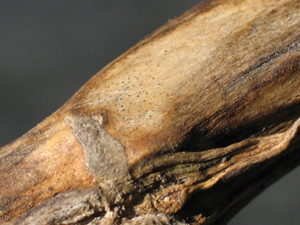
Features
Agronomy
Diseases
Blackleg in canola – resistance ratings and management options
Blackleg is one of the most serious diseases of canola in the prairies, and in some years may cause major crop losses. Through plant breeding efforts, the majority of canola varieties available today have built in resistance to blackleg,
November 7, 2008 By Top Crop Manager
Late-season scouting important for identifying blackleg risk.
 |
| Severe lodging from blackleg in an MR variety on tight rotation. |
Blackleg is one of the most serious diseases of canola in the prairies, and in some years may cause major crop losses. Through plant breeding efforts, the majority of canola varieties available today have built in resistance to blackleg, which is a very effective tool for its management. However, it is important to remember that resistance means disease tolerance, not disease immunity, and careful management is important. “Most canola varieties offer good genetic resistance for blackleg with either an R (Resistant) or MR (Moderately Resistant) rating,” explains Derwyn Hammond, Manitoba agronomy specialist for the Canola Council of Canada. “The resistance ratings currently available for commercial cultivars are based on their field performance in terms of disease severity and incidence relative to check varieties in disease testing sites.” Since the blackleg populations at most of these testing sites are likely still predominately from pathogroup 2 (PG2), which has been common in Canada for many years, it makes it difficult to predict how these lines will perform if faced with some of the different pathotypes that have recently been identified.
The Western Canada Canola/Rapeseed Recommending Committee (WCC/RRC) has established Blackleg Testing Protocols and Ratings. The following scale is used to describe the level of resistance based on average severity ratings relative to a highly susceptible variety like Westar:
R (Resistant) = <30 percent
MR (Moderately Resistant) = 30-49 percent
MS (Moderately Susceptible) = 50-69 percent
S (Susceptible) = 70-100 percent
The resistance ratings are converted to a percentage severity index for each line. The severity of blackleg infection is evaluated on a minimum of 25 plants per entry in each of four replicates after the plants are fully podded and just beginning to ripen. Plants are uprooted, cut through the stem at the site of the lesion or canker, and blackleg severity is scored for each plant using the following 0-5 scale based on the area of diseased tissue in the cross section. The severity scores must be ≥ 2.6 and ≤ 4.5.
0 – No diseased tissue visible in the cross-section.
1 – Diseased tissue occupies up to 25 percent of the cross-section.
2 – Diseased tissue occupies 26-50 percent of the cross-section.
3 – Diseased tissue occupies 51-75 percent of the cross-section.
4 – Diseased tissue occupies > 75 percent of the cross-section with little or no constriction of affected tissues.
5 – Diseased tissue occupies 100 percent of the cross-section with significant constriction of affected tissues; tissue dry and brittle; plant dead.
Management options for blackleg
Using resistant genetics and good rotations is the most effective strategy for managing blackleg. “Growing R rated varieties will provide significant suppression relative to more susceptible varieties in terms of incidence and severity of blackleg within the field, and hence better yield protection,” says Hammond. “You will get fewer, and/or less severe, lesions showing up but they will still be there. Resistant varieties are more tolerant of the disease, but they can still be a host.”
Hammond notes that managing genetic tools well is critical because it is by far the most cost-effective way of managing blackleg in canola. Using R rated varieties consistently in tighter rotations creates the most selection pressure for more virulent races in the fungal population. This provides an opportunity for genetic recombination and the creation of new more virulent isolates of the blackleg virus, which eventually can become predominant in the fungal population. This is similar to the selection of resistance in weeds through repeated applications of a herbicide.
“Pathologists are very concerned about potentially losing the genetic blackleg resistance we now rely on,” he says. “In some parts of southern Manitoba with higher frequencies of canola in rotation, elevated levels of blackleg showed up in 2007 and again in 2008.” Researchers have also positively identified isolates from all four of the main pathogroups of the blackleg fungus in Manitoba in recent years. This, combined with the elevated blackleg levels, increases the potential for selection of more virulent isolates. Researchers are working with other countries such as Australia and France in trying to learn more about different resistance genes available in different cultivars and how those match up to the fungal populations.
Rotation research shows that as rotations are intensified, the disease levels tend to increase. Growers can probably get away with a tighter rotation during a short period of time, but in the longer term the risk of running into disease problems increases. Researchers recommend a four-year rotation, with a three-year as the tightest sequence. “If you are seeing blackleg levels climbing steadily year after year, then it is definitely a signal that your rotation is a little too tight,” explains Hammond. “Growers should be backing off the amount of canola in rotation, particularly on those fields that seem to be worse infected.”
In the short term, growers who are really pushing rotations may want to consider fungicides as an additional kind of insurance application to try to suppress the disease pressure. Recent research from AAFC shows that even on highly susceptible varieties, fungicides typically only depressed incidence by 20 percent and severity ratings by about one severity point at most, which often did not translate into a significant or economical yield benefit. “Given that the R rated variety showed even smaller benefits from the fungicide application, I think most pathologists would recommend that if there is a high enough risk of blackleg to warrant a fungicide application, then it is probably time to back off that rotation,” says Hammond. “The combination of a lengthened rotation and R rated varieties will likely offer much better blackleg suppression than fungicides can offer.”
 |
| Look for picnidia on stem lesions to identify blackleg in the summer. Photos courtesy of the Canola Council of Canada. |
Scouting key to assessing risk
“Scouting canola fields throughout the season is important and will tell you something about the risk profile of your fields,” explains Hammond. “The genetic resistance has worked so well for so long that blackleg has almost become the forgotten disease in canola.” However, it has always been there, but at low enough levels that were not causing any issues.
If growers are seeing premature ripening or bleached plants for example, getting out and doing some investigation to determine the real cause is important. “If you do discover blackleg, go beyond just a visual inspection,” says Hammond. “Conduct some actual infected plant counts and calculate percentages of plants infected. Recording this information will help trace the trends in incidence and severity of the disease on your farm.”
Although late-season scouting is too late to do much about the disease in the current year, the information can be beneficial in terms of future planning. It can help growers make decisions about the most appropriate crop rotation and variety for their farm and individual fields. Growers can either do the scouting themselves, or ask their crop scouts to include late-season scouting in their planning. Good management of genetic resistance tools and rotations will help growers manage blackleg disease in canola for the long term.